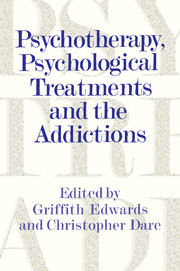Book contents
- Frontmatter
- Contents
- List of contributors
- Psychotherapy and psychological treatments of substance problems: generalism, specialism and the building of bridges
- Acknowledgements
- Part one Backgrounds to therapeutic understanding
- Part two Treatments
- 5 Psychotherapy: why do some need more and some need less?
- 6 Addictive behaviour: the next clinic appointment
- 7 Advances in families and couples therapy
- 8 Solution focused brief therapy: a co-operative approach to work with clients
- 9 Recent developments in cognitive and behavioural therapies
- 10 Cognitive and behavioural treatments for substance misuse
- 11 Motivational issues in the treatment of addictive behaviour
- 12 Can ‘stages of change’ provide guidance in the treatment of addictions? A critical examination of Prochaska and DiClemente's model
- 13 Group therapy and the addictions
- 14 Alcoholics Anonymous as mirror held up to nature
- 15 How therapeutic communities work
- Part three Postscript
- Index
9 - Recent developments in cognitive and behavioural therapies
from Part two - Treatments
Published online by Cambridge University Press: 05 August 2016
- Frontmatter
- Contents
- List of contributors
- Psychotherapy and psychological treatments of substance problems: generalism, specialism and the building of bridges
- Acknowledgements
- Part one Backgrounds to therapeutic understanding
- Part two Treatments
- 5 Psychotherapy: why do some need more and some need less?
- 6 Addictive behaviour: the next clinic appointment
- 7 Advances in families and couples therapy
- 8 Solution focused brief therapy: a co-operative approach to work with clients
- 9 Recent developments in cognitive and behavioural therapies
- 10 Cognitive and behavioural treatments for substance misuse
- 11 Motivational issues in the treatment of addictive behaviour
- 12 Can ‘stages of change’ provide guidance in the treatment of addictions? A critical examination of Prochaska and DiClemente's model
- 13 Group therapy and the addictions
- 14 Alcoholics Anonymous as mirror held up to nature
- 15 How therapeutic communities work
- Part three Postscript
- Index
Summary
Introduction
The last 15 years have seen a rapid widening of therapeutic forces from the more specific anxiety disorders and other circumscribed problem areas that first occupied the behaviourists in the 1960s and 1970s to more complex problems such as depression, generalised anxiety, panic, hypochondriasis and so on. These developments owe much to the theoretical ideas of Beck (1976), which were originally applied to the treatment of depression (Rush et al., 1977), and which have now been found to be generalisable to the treatment of wider if not all psychiatric disorders. Whilst effective for many patients (see Hollon et al., 1992 for a review of outcome efficacy in depression and Chambless and Gillis, 1993 for a review of studies in anxiety), a significant proportion of patients do not respond to Cognitive-Behavioural Therapy (CBT), and much of the outcome variance is attributable only to unexplained and uncontrolled patient factors.
Along with the expansion of the range of problems treated there has been considerable recent interest focused on the ‘difficult patient’. Developments have also occurred both in what Teasdale and Fennell (1982) called ‘the delivery system’, the way the therapeutic ideas are taught and are practiced by the patient, and in the theoretical ideas themselves and in the processes of therapy.
The present discussion will concentrate on developments in theory and therapeutic practice, presenting two approaches: the work of J. E. Young on personality disorder, and Linehan's very original therapeutic system, Dialectical Behaviour Therapy (DBT).
Schema-focused therapy (J. E. Young)
The background to Young's work (Young 1990; Young and Klosko, 1993) was his experience of working with patients with some different characteristics than those who had responded well to short-term CBT. He began encountering a group of patients whose problems were less severe or acute, who described less functional impairment, but who made little or no progress in standard CBT. These patients tended to be diagnosed as having long-term personality problems and were characterised by cognitive rigidity (a failure of beliefs to be influenced by contrary evidence), the use of avoidance strategies (cognitive, behavioural and affective) and the prominence of interpersonal problems, such as repetitive inappropriate choices of partners, overreactions to problems within the relationship, and so on.
- Type
- Chapter
- Information
- Psychotherapy, Psychological Treatments and the Addictions , pp. 139 - 157Publisher: Cambridge University PressPrint publication year: 1996



